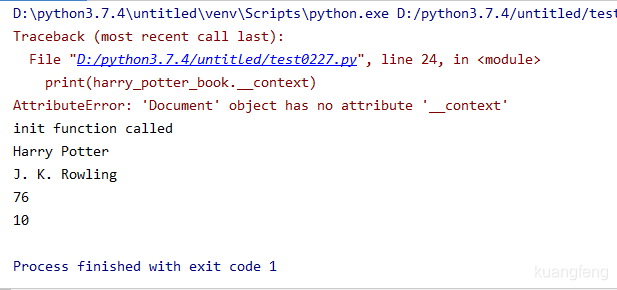一、前言
1.类、对象、属性、函数
例子
class Document():
def __init__(self, title, author, context):
print('init function called')
self.title = title
self.author = author
self.__context = context # __ 开头的属性是私有属性
def get_context_length(self):
return len(self.__context)
def intercept_context(self, length):
self.__context = self.__context[:length]
harry_potter_book = Document('Harry Potter', 'J. K. Rowling', '... Forever '
'Do not believe any thing is capable of thinking independently...')
print(harry_potter_book.title)
print(harry_potter_book.author)
print(harry_potter_book.get_context_length())
harry_potter_book.intercept_context(10)
print(harry_potter_book.get_context_length())
print(harry_potter_book.__context)

context为私有属性
- 类:一群有着相似性的事物的集合,这里对应Python的class
- 对象:集合中的一个事物,这里对应由class生成某一个object,比如代码中的harry_potter_book
- 属性:对象的某个静态特征,比如上述代码中的title、author和__context
- 函数:对象的某个动态能力,比如上述代码中的intercept_context()函数
类,一群有着相同属性和函数的对象的集合
2.类函数、成员函数、静态函数
例子
class Document():
WELCOME_STR = 'Welcome! The context for this book is {}.'
def __init__(self, title, author, context):
print('init function called')
self.title = title
self.author = author
self.__context = context
# 类函数
@classmethod
def create_empty_book(cls, title, author):
return cls(title=title, author=author, context='nothing')
# 成员函数
def get_context_length(self):
return len(self.__context)
# 静态函数
@staticmethod
def get_welcome(context):
return Document.WELCOME_STR.format(context)
empty_book = Document.create_empty_book('What Every Man Thinks About Apart from Sex', 'Professor Sheridan Simove')
print(empty_book.get_context_length())
print(empty_book.get_welcome('indeed nothing'))

- 静态函数
一般而言,静态函数可以用来做一些简单独立的任务,即方便测试,也能优化代码结构。静态函数还可以通过前一行加上
@staticmethod来表示,代码中也有相应的示例。
- 类函数
而函数的第一个参数一般为
cls,表示必须传一个类进来。类函数最常用的功能是实现不同的init构造函数,比如上述代码中,create_empty_book类函数,来创造新的书籍对象,其context一定为nothing。这样的代码,比直接构造要清晰一点。类似的,类函数需要装饰器@classmethod来声明。
- 成员函数
成员函数则是我们最正常的类的函数,不需要任何装饰器声明,第一个参数
self代表当前对象的引用,可以通过此函数,来实现想要的查询/修改类的属性等功能。
3.继承
- 类的继承
指的是一个类既拥有另一个类的特征,也拥有不用于另一类的独特特征
第一个类叫做子类(派生类)
另一个类叫做父类(基类)
例子
class Entity():
def __init__(self, object_type):
print('parent class init called')
self.object_type = object_type
def get_context_length(self):
raise Exception('get_context_length not implemented')
def print_title(self):
print(self.title)
class Document(Entity):
def __init__(self, title, author, context):
print('Document class init called')
Entity.__init__(self, 'document')
self.title = title
self.author = author
self.__context = context
def get_context_length(self):
return len(self.__context)
class Video(Entity):
def __init__(self, title, author, video_length):
print('Video class init called')
Entity.__init__(self, 'video')
self.title = title
self.author = author
self.__video_length = video_length
def get_context_length(self):
return self.__video_length
harry_potter_book = Document('Harry Potter(Book)', 'J. K. Rowling',
'... Forever Do not believe any thing is capable of thinking independently...')
harry_potter_movie = Video('Harry Potter(Movie)', 'J. K. Rowling', 120)
print(harry_potter_book.object_type)
print(harry_potter_movie.object_type)
harry_potter_book.print_title()
harry_potter_movie.print_title()
print(harry_potter_book.get_context_length())
print(harry_potter_movie.get_context_length())

- get_context_length()函数
函数重载
子类再写一遍,覆盖原有函数
- print_title()函数
这个函数在父类里,这便是继承
4.抽象函数和抽象类
例子
from abc import ABCMeta, abstractmethod
class Entity(metaclass=ABCMeta):
@abstractmethod
def get_title(self):
pass
@abstractmethod
def set_title(self, title):
pass
class Document(Entity):
def get_title(self):
return self.title
def set_title(self, title):
self.title = title
document = Document()
document.set_title('Harry Potter')
print(document.get_title())
entity = Entity()

Entity本身是没什么用的,只需定义
Document和Video的一些基本元素就够。但是如果生成了一个Entity的对象就要用到抽象类了。
- 抽象类
是一种特殊的类,作为父类存在,一旦对象化就会报错。
抽象函数定义在抽象类中,子类也必须重载函数才能使用
装饰器
@abstractmetgod来表示
5.面向对象编程
- 面对对象编程
把一组数据结构和处理它们的方法组成对象(object),把相同行为的对象归纳为类(class),通过类的封装(encapsulation)隐藏内部细节,通过继承(inheritance)实现类的特化(specialization)和泛化(generalization),通过多态(polymorphism)实现基于对象类型的动态分派
